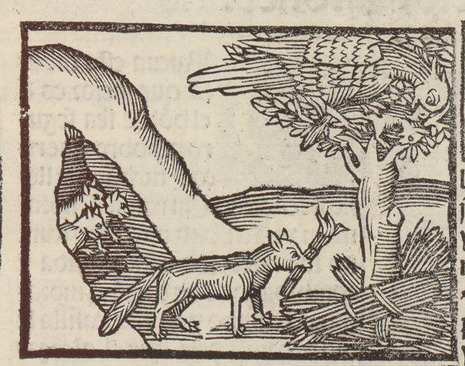I decided to start with Perry #1, the story of the the fox, the eagle, and their offspring. At the Aesopus wiki, you can see a complete list of the versions of this fable that I have collected. This is a rather complicated fable to start with, since it appears in two quite distinct variants. In one set of stories (predominantly in the Greek tradition, but also in the later Latin and then English traditions), the eagle kidnaps the fox's cubs and feeds them to her chicks, whereupon the fox exacts a terrible vengeance so that the eagle's nest catches on fire and her chicks are killed. In a more optimistic variation (represented in Phaedrus and his imitators), the eagle kidnaps the fox's cubs but returns them when the fox threatens to do harm to the chicks; as a result, no harm comes to either the fox's cubs or the eagle's chicks.
Here is the version in Steinhowel's Aesop (1.13):
Potentes metuere debere infimos haec attestatur fabula. Vulpinos catulos aquila rapuit ac in nidum deportavit, ut pullis suis escam daret; prosecuta vulpes aquilam rogabat catulos suos sibi reddi. Aquila contempsit vulpem quasi inferiorem; vulpes plena dolo ab ara ignem rapuit et arborem circumdedit, collecta stipula. Cumque fumus et flamma perstreperent, aquila, dolore pulsa natorum, ne flammis simul perirent, incolumes vulpinos catulos supplex reddidit matri. Docet haec fabula multos, ne quis insultet inferiori et ab aliqua flamma vindictae incendatur.
Here it is written out in segmented style to make it easier to follow, while respecting the Latin word order:
Potentes
metuere debere infimos
haec attestatur fabula.
Vulpinos catulos
aquila rapuit
ac in nidum deportavit,
ut pullis suis escam daret;
prosecuta vulpes aquilam
rogabat
catulos suos sibi reddi.
Aquila
contempsit vulpem
quasi inferiorem;
vulpes
plena dolo
ab ara ignem rapuit
et arborem circumdedit,
collecta stipula.
Cumque fumus et flamma perstreperent,
aquila,
dolore pulsa natorum,
ne flammis simul perirent,
incolumes vulpinos catulos
supplex
reddidit matri.
Docet haec fabula
multos,
ne quis
insultet inferiori
et
ab aliqua flamma vindictae
incendatur.
The fact that the fox grabs the flame ab ara, from an altar, is the link between this version and the ancient Greek tradition, in which it is a kind of divine justice (flame from the altar of the gods) which is at work in the story. Although the Roman poet Phaedrus seems to have initiated the version of the fable in which the mere threat of violence secures the release of the fox's cubs, he still includes the detail of the altar (Vulpes rapuit ab ara ardentem facem), which of course made much more sense in his time than it did for later Latin authors in the Middle Ages and Renaissance. Notice that in William Caxton, the altar which is still found in Steinhowel is no longer included: And thenne the foxe fulle of shrewdnes and of malyce beganne to put to gyder grete habondaunce of strawe round aboute the tree / where vpon the egle and his yonge were in theyr nest / and kyndeled it with fyre.
For an illustration, here is an image from Steinhowel's Aesop which shows the fox as she methodically builds the fire around the tree!

For more information about subscribing to this blog via RSS or by email, visit the Bestiaria Latina blog using the link provided here.
No comments:
Post a Comment